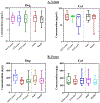Urinary and fecal excretion of aromatic amines in pet dogs and cats from the United States
- PMID: 35366557
- PMCID: PMC9035069
- DOI: 10.1016/j.envint.2022.107208
Urinary and fecal excretion of aromatic amines in pet dogs and cats from the United States
Abstract
Several primary aromatic amines (AAs) are known or suspected carcinogens. Despite this, the exposure of pet animals to this class of chemicals is unknown. In this study, we investigated the occurrence of 30 AAs and two tobacco chemical markers (nicotine and cotinine) in 63 pet urine (42 dog and 21 cat) and 77 pet feces (37 dog and 40 cat) samples collected from the Albany area of New York State. Eight of the 30 AAs (∑8AAs) were found in > 38% of dog and cat urine samples, at median concentrations of 7.99 (range: 0.42-52.3 ng/mL) and 31.4 (2.63-75.9) ng/mL, respectively. Nine of the 30 AAs (∑9AAs) were found in > 73% of dog and cat feces samples, at median concentrations of 278 (range: 61.7-613 ng/g) and 240 (55.4-645) ng/g dry wt, respectively. Among the 30 AAs, 2,6-dimethylaniline (2,6-DMA) accounted for the highest median concentrations in both urine and fecal samples. Median concentrations of nicotine and cotinine were below 0.92 ng/mL in urine and below 3.86 ng/g in feces of both dogs and cats. No significant relationship was found between AA concentrations and pet age or gender. The lack of significant Spearman's rank correlation between the concentrations of AA and nicotine in pet urine/feces suggested that sources other than tobacco smoke contributed to AA exposure in pets. Furthermore, the calculated fecal excretion rates of AAs were higher than the intake rates (estimated through reverse dosimetry), which indicates that cats and dogs are exposed to AA precursors such as azo dyes. Concentrations in urine and feces reflected exposure to direct and indirect exposure sources, respectively, of AAs.
Keywords: Aniline; Aromatic amines; Biomonitoring; Cotinine; LC-MS/MS; Pets.
Copyright © 2022 The Authors. Published by Elsevier Ltd.. All rights reserved.
Conflict of interest statement
Conflict of Interest
The authors declare no competing financial interest.
Declaration of interests
The authors declare that they have no known competing financial interests or personal relationships that could have appeared to influence the work reported in this paper.
Figures



Similar articles
-
An exposure assessment of 27 quaternary ammonium compounds in pet dogs and cats from New York State, USA.Environ Int. 2024 Feb;184:108446. doi: 10.1016/j.envint.2024.108446. Epub 2024 Jan 19. Environ Int. 2024. PMID: 38252984 Free PMC article.
-
Variability in urinary concentrations of primary aromatic amines.Sci Total Environ. 2022 Jul 20;831:154768. doi: 10.1016/j.scitotenv.2022.154768. Epub 2022 Mar 24. Sci Total Environ. 2022. PMID: 35341833 Free PMC article.
-
Profiles of primary aromatic amines, nicotine, and cotinine in indoor dust and associated human exposure in China.Sci Total Environ. 2022 Feb 1;806(Pt 4):151395. doi: 10.1016/j.scitotenv.2021.151395. Epub 2021 Nov 3. Sci Total Environ. 2022. PMID: 34740640 Free PMC article.
-
Minimal zoonotic risk of cryptosporidiosis from pet dogs and cats.Trends Parasitol. 2010 Apr;26(4):174-9. doi: 10.1016/j.pt.2010.01.004. Epub 2010 Feb 20. Trends Parasitol. 2010. PMID: 20176507 Review.
-
Amino Acids in the Nutrition, Metabolism, and Health of Domestic Cats.Adv Exp Med Biol. 2021;1285:217-231. doi: 10.1007/978-3-030-54462-1_11. Adv Exp Med Biol. 2021. PMID: 33770409 Review.
Cited by
-
Unexpected Exposure Risks to Emerging Aromatic Amine Antioxidants and p-Phenylenediamine Quinones to Residents: Evidence from External and Internal Exposure as Well as Hepatotoxicity Evaluation.Environ Health (Wash). 2024 Feb 19;2(5):278-289. doi: 10.1021/envhealth.3c00205. eCollection 2024 May 17. Environ Health (Wash). 2024. PMID: 39474324 Free PMC article.
-
An assessment of exposure to several classes of pesticides in pet dogs and cats from New York, United States.Environ Int. 2022 Nov;169:107526. doi: 10.1016/j.envint.2022.107526. Epub 2022 Sep 14. Environ Int. 2022. PMID: 36155914 Free PMC article.
-
Liquid crystal monomers in human, dog and cat feces from the United States.J Hazard Mater. 2024 Dec 5;480:136144. doi: 10.1016/j.jhazmat.2024.136144. Epub 2024 Oct 10. J Hazard Mater. 2024. PMID: 39405681
-
Occurrence of primary aromatic amines and nicotine in sediments collected from the United States.Sci Total Environ. 2022 Dec 10;851(Pt 1):158102. doi: 10.1016/j.scitotenv.2022.158102. Epub 2022 Aug 17. Sci Total Environ. 2022. PMID: 35987249 Free PMC article.
-
An exposure assessment of 27 quaternary ammonium compounds in pet dogs and cats from New York State, USA.Environ Int. 2024 Feb;184:108446. doi: 10.1016/j.envint.2024.108446. Epub 2024 Jan 19. Environ Int. 2024. PMID: 38252984 Free PMC article.
References
-
- Baan R; Straif K; Grosse Y; Secretan B; El Ghissassi F; Bouvard V; Benbrahim-Tallaa L; Cogliano V; W, W.I.A.R.C.M. 2008. Special Report: Policy: Carcinogenicity of some aromatic amines, organic dyes, and related exposures. Lancet Oncol. 9, 322–323 - PubMed
-
- Campanella G; Ghaani M; Quetti G; Farris S 2015. On the origin of primary aromatic amines in food packaging materials. Trends Food Sci Tech. 46, 137–143
Publication types
MeSH terms
Substances
Grants and funding
LinkOut - more resources
Full Text Sources
Miscellaneous

